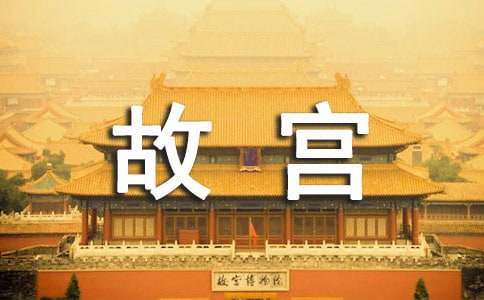故宮導游詞英文
明清的兩代皇宮,也叫“紫禁城”。它始建于1406年,距今已有600年了。經過多個朝代的建造現在這故宮是目前保存最完好的故宮,也是規模最大的古代宮殿建筑群。如下是小編給大家整理的故宮導游詞,希望對大家有所作用。

故宮導游詞篇【一】
Ladies and Gentlemen:
I am pleased to serve as your guide today.
This is the palace museum; also know as the Purple Forbidden City. It is the largest and most well reserved imperial residence in China today. Under Ming Emperor Yongle, construction began in 1406. It took 14years to build the Forbidden City. The first ruler who actually lived here was Ming Emperor Zhudi. For five centuries thereafter, it continued to be the residence of23 successive emperors until 1911 when Qing Emperor Puyi was forced to abdicate the throne. In 1987, the United Nations Educational, Scientific and Cultural Organization recognized the Forbidden City was a world cultural legacy.
It is believed that the Palace Museum, or Zi Jin Cheng (Purple Forbidden City), got its name from astronomy folklore, The ancient astronomers divided the constellations into groups and centered them around the Ziwei Yuan (North Star) . The constellation containing the North Star was called the Constellation of Heavenly God and star itself was called the purple palace. Because the emperor was supposedly the son of the heavenly gods, his central and dominant position would be further highlighted the use of the word purple in the name of his residence. In folklore, the term “an eastern purple cloud is drifting” became a metaphor for auspicious events after a purple cloud was seen drifting eastward immediately before the arrival of an ancient philosopher, LaoZi, to the Hanghu Pass. Here, purple is associated with auspicious developments. The word jin (forbidden) is self-explanatory as the imperial palace was heavily guarded and off-explanatory as the imperial palace was heavily guarded and off-limits to ordinary people.
The red and yellow used on the palace walls and roofs are also symbolic. Red represents happin
故宮導游詞篇【二】
Lying at the center of Beijing, the Forbidden City, called Gu Gong, in Chinese, was the imperial palace during the Ming and Qing dynasties. Now known as the Palace Museum, it is to the north of Tiananmen Square. Rectangular in shape, it is the world‘s largest palace complex and covers 74 hectares. Surrounded by a six meter deep moat and a ten meter high wall are 9,999 buildings. The wall has a gate on each side. Opposite the Tiananmen Gate, to the north is the Gate of Devine Might (Shenwumen), which faces Jingshan Park. The distance between these two gates is 960 meters, while the distance between the gates in the east and west walls is 750 meters. There are unique and delicately structured towers on each of the four corners of the curtain wall. These afford views over both the palace and the city outside. The Forbidden City is divided into two parts. The southern section, or the Outer Court was where the emperor exercised his supreme power over the nation. The northern section, or the Inner Court was where he lived with his royal family. Until 1924 when the last emperor of China was driven from the Inner Court, fourteen emperors of the Ming dynasty and ten emperors of the Qing dynasty had reigned here. Having been the imperial palace for some five centuries, it houses numerous rare treasures and curiosities. Listed by UNESCO as a World Cultural Heritage Site in 1987, the Palace Museum is now one of the most popular tourist attractions world wide.
Construction of the palace complex began in 1407, the 5th year of the Yongle reign of the third emperor of the Ming dynasty. It was completed fourteen years later in 1420. It was said that a million workers including one hundred thousand artisans were driven into the long-term hard labor. Stone needed was quarried from Fangshan, a suburb of Beijing. It was said a well was dug every fifty meters along the road in order to pour water onto the road in winter to slide huge stones on ice into the city. Huge amounts of timber and other materials were freighted from faraway provinces. Ancient Chinese people displayed their very considerable skills in building the Forbidden City. Take the grand red city wall for example. It has an 8.6 meters wide base reducing to 6.66 meters wide at the top. The angular shape of the wall totally frustrates attempts to climb it. The bricks were made from white lime and glutinous rice while the cement is made from glutinous rice and egg whites. These incredible materials make the wall extraordinarily strong.
Since yellow is the symbol of the royal family, it is the dominant color in the Forbidden City. Roofs are built with yellow glazed tiles; decorations in the palace are painted yellow; even the bricks on the ground are made yellow by a special process. However, there is one exception. Wenyuange, the royal library, has a black roof. The reason is that it was believed black represented water then and could extinguish fire.
Nowadays, the Forbidden City, or the Palace Museum is open to tourists from home and abroad. Splendid painted decoration on these royal architectural wonders, the grand and deluxe halls, with their surprisingly magnificent treasures will certainly satisfy "modern civilians".
【故宮導游詞英文】相關文章:
故宮英文導游詞06-19
故宮英文導游詞集錦06-19
北京故宮英文導游詞(精選11篇)05-14
北京故宮導游詞「中英文」03-14
北京故宮英文導游詞(通用10篇)04-18
故宮導游詞11-27
故宮導游詞06-25
故宮導游詞06-12
精選故宮導游詞03-13
介紹故宮的導游詞范文介紹故宮的導游詞03-28